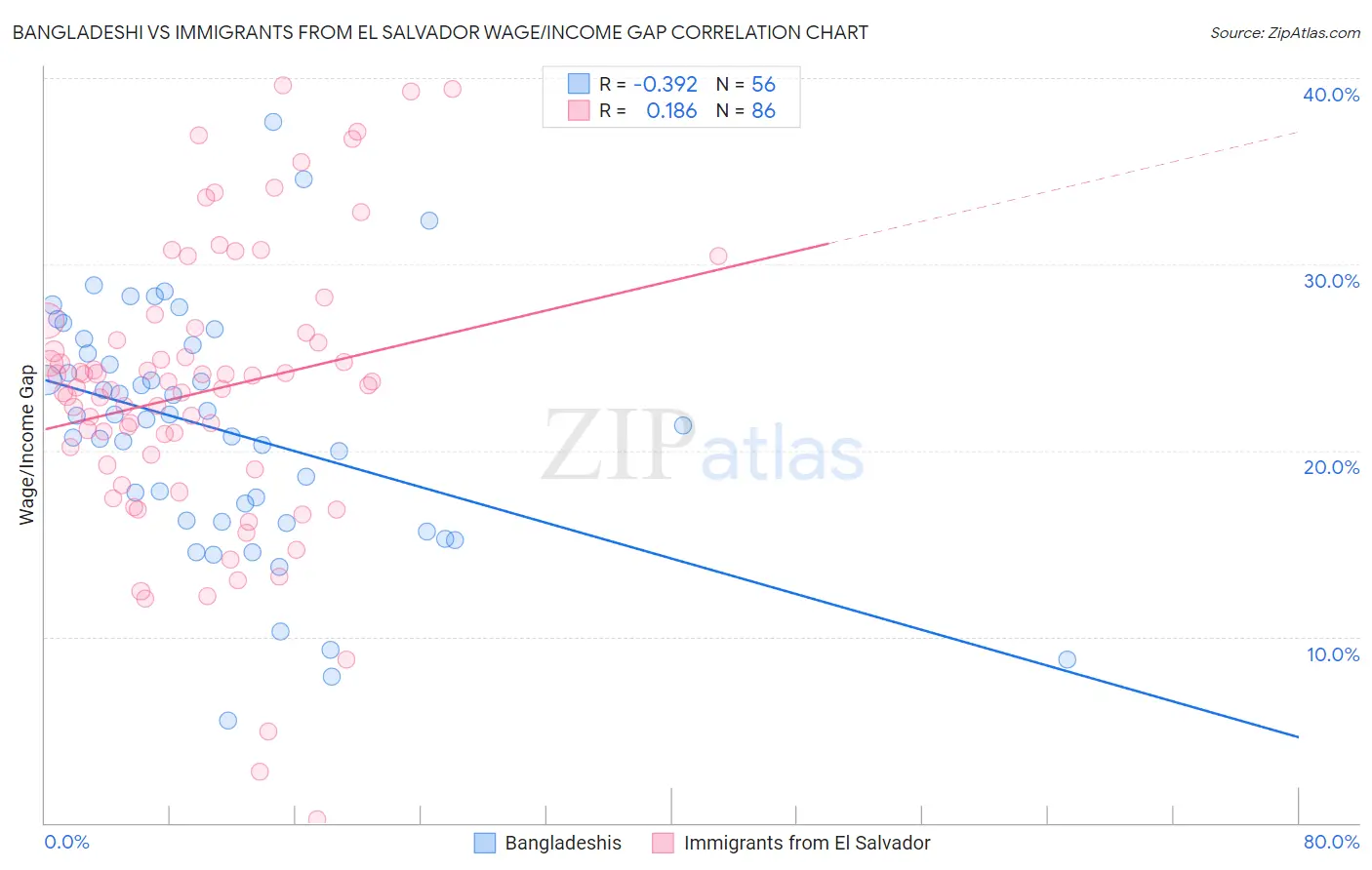Bangladeshi vs Immigrants from El Salvador Wage/Income Gap
COMPARE
Bangladeshi
Immigrants from El Salvador
Wage/Income Gap
Wage/Income Gap Comparison
Bangladeshis
Immigrants from El Salvador
22.2%
WAGE/INCOME GAP
100.0/ 100
METRIC RATING
53rd/ 347
METRIC RANK
22.8%
WAGE/INCOME GAP
99.9/ 100
METRIC RATING
71st/ 347
METRIC RANK
Bangladeshi vs Immigrants from El Salvador Wage/Income Gap Correlation Chart
The statistical analysis conducted on geographies consisting of 141,421,838 people shows a mild negative correlation between the proportion of Bangladeshis and wage/income gap percentage in the United States with a correlation coefficient (R) of -0.392 and weighted average of 22.2%. Similarly, the statistical analysis conducted on geographies consisting of 357,610,247 people shows a poor positive correlation between the proportion of Immigrants from El Salvador and wage/income gap percentage in the United States with a correlation coefficient (R) of 0.186 and weighted average of 22.8%, a difference of 2.8%.

Wage/Income Gap Correlation Summary
| Measurement | Bangladeshi | Immigrants from El Salvador |
| Minimum | 5.5% | 0.18% |
| Maximum | 37.6% | 39.6% |
| Range | 32.1% | 39.4% |
| Mean | 21.1% | 23.2% |
| Median | 21.8% | 23.4% |
| Interquartile 25% (IQ1) | 16.2% | 19.2% |
| Interquartile 75% (IQ3) | 25.4% | 26.3% |
| Interquartile Range (IQR) | 9.2% | 7.1% |
| Standard Deviation (Sample) | 6.5% | 7.7% |
| Standard Deviation (Population) | 6.5% | 7.7% |
Demographics Similar to Bangladeshis and Immigrants from El Salvador by Wage/Income Gap
In terms of wage/income gap, the demographic groups most similar to Bangladeshis are Immigrants from Cameroon (22.2%, a difference of 0.010%), Nepalese (22.2%, a difference of 0.23%), Immigrants from Zaire (22.3%, a difference of 0.63%), Immigrants from Ghana (22.3%, a difference of 0.66%), and Ghanaian (22.3%, a difference of 0.76%). Similarly, the demographic groups most similar to Immigrants from El Salvador are Subsaharan African (22.8%, a difference of 0.15%), Immigrants from Uzbekistan (22.7%, a difference of 0.17%), Indonesian (22.7%, a difference of 0.28%), Menominee (22.7%, a difference of 0.31%), and Immigrants from Nigeria (22.7%, a difference of 0.31%).
| Demographics | Rating | Rank | Wage/Income Gap |
| Immigrants | Cameroon | 100.0 /100 | #52 | Exceptional 22.2% |
| Bangladeshis | 100.0 /100 | #53 | Exceptional 22.2% |
| Nepalese | 100.0 /100 | #54 | Exceptional 22.2% |
| Immigrants | Zaire | 100.0 /100 | #55 | Exceptional 22.3% |
| Immigrants | Ghana | 100.0 /100 | #56 | Exceptional 22.3% |
| Ghanaians | 100.0 /100 | #57 | Exceptional 22.3% |
| Immigrants | Cuba | 100.0 /100 | #58 | Exceptional 22.4% |
| Navajo | 100.0 /100 | #59 | Exceptional 22.4% |
| Immigrants | Middle Africa | 100.0 /100 | #60 | Exceptional 22.4% |
| Immigrants | Fiji | 100.0 /100 | #61 | Exceptional 22.4% |
| Immigrants | Guatemala | 100.0 /100 | #62 | Exceptional 22.5% |
| Immigrants | Ecuador | 100.0 /100 | #63 | Exceptional 22.5% |
| Spanish American Indians | 100.0 /100 | #64 | Exceptional 22.5% |
| Guatemalans | 99.9 /100 | #65 | Exceptional 22.6% |
| Central American Indians | 99.9 /100 | #66 | Exceptional 22.7% |
| Menominee | 99.9 /100 | #67 | Exceptional 22.7% |
| Immigrants | Nigeria | 99.9 /100 | #68 | Exceptional 22.7% |
| Indonesians | 99.9 /100 | #69 | Exceptional 22.7% |
| Immigrants | Uzbekistan | 99.9 /100 | #70 | Exceptional 22.7% |
| Immigrants | El Salvador | 99.9 /100 | #71 | Exceptional 22.8% |
| Sub-Saharan Africans | 99.9 /100 | #72 | Exceptional 22.8% |